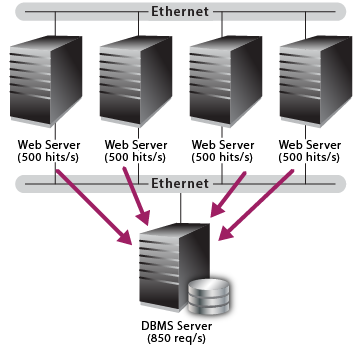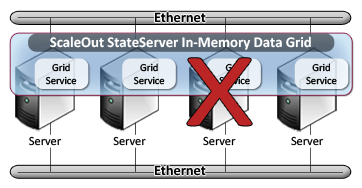Advantages
Advantages over a Database Server
ScaleOut StateServer is intended to complement and offload your database management server (DBMS) in managing mission-critical, business data. Your DBMS does an outstanding job of storing and retrieving large volumes of slowly changing data (such as purchase orders, customer and employee records, and inventory) over the long term. However, ScaleOut StateServer has several advantages over the use of a DBMS (or a standalone storage server) to store the fast changing, application-generated workload data your server farm must handle. Here’s why:
It eliminates the bottleneck created by a centralized DBMS by allowing simultaneous access to multiple data objects stored on different servers. ScaleOut StateServer’s fast, in-memory storage also avoids the additional overheads associated with disk access and with the use of a DBMS. The following diagram illustrates the performance bottleneck created by a centralized DBMS:

Unlike a centralized DBMS, ScaleOut StateServer’s performance grows as the server farm grows. This keeps response times low, and gives you the flexibility to scale your infrastructure to meet increased business demands. Because you just add servers to the farm to increase performance, your incremental cost remains low compared to replacing a large, back-end database server. The following figure illustrates the power of ScaleOut StateServer’s scalability:

ScaleOut StateServer makes use of the N-way redundancy inherent in a server farm. When a server fails, the remaining servers take on the failed server’s share of the workload data, and they maintain highly available access to stored data. This also allows you to take a server down for planned maintenance while maintaining the service’s high availability. A standalone DMBS or storage server usually cannot be taken offline without disrupting operations.

ScaleOut StateServer typically recovers much faster than a clustered DBMS because it doesn’t have to restart the service process on another server. All servers in the farm are active and can handle access requests. In most cases, ScaleOut StateServer only requires about ten seconds or less to detect that a server is unavailable and route access requests to other servers.
ScaleOut StateServer’s self-discovery, self-aggregation, and self-healing technology make it easier to manage than a complex, clustered DBMS. Keeping management overhead to a minimum lowers your costs and improves reliability
Using ScaleOut StateServer, you can keep your workload data close to where it is needed by using the distributed cache as an intermediate storage tier. This lets you optimize performance, and if your DBMS is kept behind a firewall, it avoids the need to traverse the firewall to store rapidly changing data.
ScaleOut StateServer’s simple, straightforward semantics make it easy to store and retrieve serializable data objects in your application programs. This lets you avoid the complexity and overhead of database access for managing simple program objects.
ScaleOut StateServer typically is significantly less expensive (at least 3X lower cost and 10X lower cost/update) than even low cost, failover database clusters.
ScaleOut GeoServer’s data replication is a fast and cost-effective alternative to using DBMS replication for synchronizing cached data across remote sites.